How inclusive is the technology in your workplace?
Arriving back in the UK from a recent trip abroad, it was interesting to see most travellers being asked to use the e-passport machines rather than queuing up to show passports to a human. Which, for many passengers, was not a problem. But, for some, it can be a little more challenging. When you submit your photo for your UK passport, it is usually taken without your glasses on but, if you usually wear glasses, you might need them to read the instructions on the e-passport machine and this doesn’t match the photo being scanned by the machine and matched to you standing at the machine.
And it got me thinking…….
What if the technology in your workplace makes the job harder rather than easier for some employees? What if you have something about you that hinders your use of the technology? Not necessarily enough to need a disability reasonable adjustment (although those are, of course, essential) but something in the design, implementation or assumptions around technology that make it difficult for you?
For example, having certain colour combinations in a dashboard report can make it harder to read or understand for anyone who is colour blind, some people with dyslexia, or other visual difficulties. Even just tired eyes can find some colour combinations more challenging than others. Just adding written labels as well as using colour can be helpful.
How about those who have issues with manual dexterity? This could be from a previous injury, from age related arthritis in the finger joints, from another underlying condition, down to someone’s hand size or affected by the temperature at which they are working. What if everything at work is user self service and on apps or a tablet? This can make delivering work slower and harder for these individuals. Is this taken in to account when looking at performance, outputs and targets?
How about an organisation using face recognition software for access to the office? Depending on how the system has been set up, does it consistently and correctly recognise employees who change their appearance in any way? Whether that’s female employees more likely to have different hairstyles, anyone experiencing a facial injury, or trans employees, not being recognised by your own office will have a detrimental impact on an individual. More extreme are some earlier systems where the AI algorithm was “taught” to recognise faces on a majority white student population where it was developed in the US, resulting in people who were non-white failing to be recognised correctly (see short film Coded Bias for more on this).
Similarly, what benchmark or success measure does your organisation use in any recruitment technology you deploy? If you measure the attributes of your current senior management population as representative of success, will you be measuring for clones when you recruit to the organisation? Does this automatically limit the diversity of your recruitment process? This can apply even where you are not engaging AI but where you apply unnecessary criteria such as degree level qualification just to sift the amount of applications to a manageable level.
We all know the use of correct pronouns is important when engaging with our colleagues and have probably added our own on our Linked In profile. But, does your organisation’s email system allow for use of pronouns in your standard email signature as a default option? Do you record pronouns as a useable field on your HRIS?
There are more examples of how technology might be hindering your EDI initiatives and intentions so, if you want to chat about the use of technology in your organisation and how we could work together to make improvements, particularly for your HR team, get in touch for a free initial consultation.




